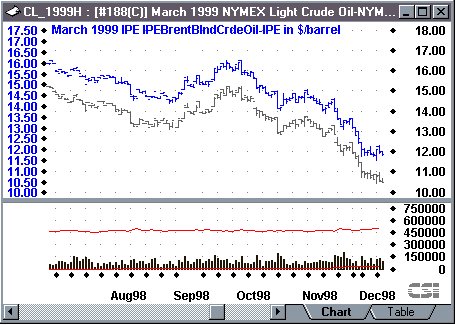PAGE 1
This Issue
January 1999

Various Topics
Page 1

Tech Talk
Page 2

Market Statistics
Update & IPO's
Page 3
Notice:
The views and
information expressed in this document reflect the opinions and experience of
the author Robert C. Pelletier. Neither CSI nor the author undertake or
intend to provide tax advice or trading advice in any market or endorse any
outside individual or firm. All recommendations are provided for their
informational value only. Readers should consult competent financial
advisors or outside counsel before making any software purchase or investment
decision. CSI does not stand behind or endorse the products of any
outside firms.
Copyright (c) 1998 Commodity Systems Inc.
(CSI). All rights are reserved.
|
Topics discussed in this month's
journal.
IPE Brent Crude Data Mirrors NYMEX
Light Crude
Did you know that by examining the
performance of NYMEX Light Crude, you can predict within less than 1% the
precise closing prices of Brent Crude on the IPE exchange about 99% of the
time?
It's simple: You just take the
open, high, low, and close of any given contract of the NYMEX market and add in
the prior day's closing price spread (currently about $1.14 per barrel). The
result will be the value of the IPE market statistics within about 1%. That
$1.14 constant applies to the current-day differential as of the time of
writing. As the price of crude rises, the exact differential will rise
slightly, but the idea is that you don't need to subscribe to the statistics of
the IPE to know what will go on there each and every day. Incidentally, both
markets trade simultaneous coincident hours and both are quoted in dollars. The
$1.14 differential has to do with points of delivery and other contract details
which depend upon respective price levels.
If you are paying the IPE fee in
excess of $9,000 per year to enjoy the privilege of a Sub Vendor, you may be
wasting your money. Don't pay it; compute it! And save money in the
process.
The chart of March 1999 Light Crude
and Brent Crude show the remarkably similar images of the two contracts from
both exchanges. There may be arbitrage opportunities intraday between these two
markets, but they must be noticeably insignificant.

Dear Concerned User of the MetaStock®
Format:
RE: Data Quality, Not Format Secrecy
Cultivates User Loyalty
As we said in last month's edition
of the CSI Technical Journal, there could be a problem for users who depend
upon the MetaStock format through and beyond the year 2000.
It is our belief that MetaStock
does not plan to make it simple for users of their format to reach beyond the
end of 1999. One source told me that they would not attempt to encrypt or
encode their format, but that they would not necessarily be willing helpers in
the conversion process. I'm also told that MetaStock may not yet know what
their new format will look like.
We certainly hope that MetaStock
and Reuters will be open about their new format changes. Keeping format details
secret for a publicly offered product like MetaStock is tantamount to
Microsoft® keeping their Windows architecture secret so that the non-Microsoft
browser market couldn't be accessed through a Windows interface.
In case the worst occurs, to get around the
problem of not knowing MetaStock's new format, we at CSI have extended the old
CompuTrac/MetaStock format that current users read and use to process their
data into what we will be identifying as the CSI Millenium or CSIM format. This
format will work with both QuickTrieve and Unfair Advantage through the 21st
century and for periods back into the 1800s. The details of this format have
been posted on our web site for our users and in hopes that MetaStock might
want to make their software compliant.
The new CSIM format may very well
become a more popular format than the one MetaStock plans to move into. This is
true for the simple reason that we are not the least bit afraid to be open
about how to write programs for it. At CSI, we earn our business based upon
excellence in data accuracy, world database scope, and timely delivery; Not
upon a secret format that may keep customers loyal for all the wrong reasons.
In fact, we encourage all of our competitors and other data firms to use the
CSIM format.
We have asked MetaStock for details
on their new format, and perhaps they will eventually comply. MetaStock has
told CSI in the past that we are considered some form of a competitor. This may
have been disputable in the past, but now that MetaStock is owned by the giant
known as Reuters, their assertion may be closer to the truth.
Reuters supplies world market news
and information on equities, futures and cash markets. In the recent past, they
decided to sell end-of-day data on various markets in direct competition with
CSI. We welcome the competition, and in no way do we lament their decision.
Reuters is a past commercial customer of CSI, and we sold them data not knowing
that they had plans to compete in the same arena. They obviously know that we
do a good job or they wouldn't have depended upon us
S&C's Winner is Software
Developers' Choice
Every year about this time, traders
thumb through S&C's trademark publication (sent out in mid January) to see
which firms are honored for their contributions in areas of data, software and
finance. Each year I cringe at the results, which somehow elevate seemingly
undeserving firms to the top of the list. After the awards, you will inevitably
see the winners touting their achievement through advertisements.
What's wrong with this picture?
Let's start with the award itself. The problem has to do with the implication
of the word "choice." Webster's dictionary defines choice as "the act of
selecting from among two or more things, that which is preferred."
Technically, S&C worded their ballot properly, but they failed to disclose
the subtle forces that will discredit the results.
Chief among the design flaws is the
fact that the ballot is incomplete. Although readers might assume that all
products and services within a category are fairly presented on the ballots,
this is not the case. When you see S&C's survey results, you may notice
that in spite of our advertising presence in the magazine since they began
printing back in 1979, they have left CSI out of the category,
"Data-Historical." They also left CSI's Unfair Advantage® out of the
category, "Software-Data Download." It is pretty much a given that we
will not win in those areas, where our only possibility lies with write-in
entries.
Another flaw we see in the process
has to do with undisclosed inter-company alliances. Although not widely known,
it is a common practice for software firms to remove choice altogether with
regard to the corresponding services their software supports. The software of
some visible firms works with just a few data firms who will kick back 50%
(more or less) of their data collection revenue. Because marketing expenses are
quite high, both parties can argue that the kickback is merely a marketing fee.
Although there is really nothing wrong with this practice, it places
behind-the-scenes influences on Reader's Choice balloting and vastly distorts
the accuracy of the survey.
Kickbacks apparently are the norm, but if
a firm is viewed as a possible competitor (as Omega and MetaStock consider
CSI), then that firm would not be a published option for data. In many cases,
when subscribers fill in their ballots, they are simply identifying the
companies their software developer recommended. The "Choice" in S&C's award
becomes that of the software vendor, not the reader.
Omega Research, MetaStock® and
Windows On Wall Street® give users a choice when they supply custom downloader
software, but none of these firms will include CSI on their menus, even though
our data may be cleaner and our fees lower. (WOW said they may at a later
date.) Their downloaders typically direct users to Dial Data®, Genesis,
Telescan®, and Reuters®. Because these software firms contribute the most
business to the End-of-Day data community, CSI. will always receive a minority
vote. We are simply unknown to most traders. Omega Research products read the
CSI format, however, and through the ASCII, CSI and the MetaStock formats, we
are compatible with their products. Fortunately, CSI is both preferred and
engaged by many independent-minded traders and by many professional software
developers who will not compromise data scope, quality, service and support for
their users.
To their credit, the editors at
Stocks & Commodities Magazine apparently attempted to make it a fair
contest. They sent a survey to their subscribers (non-advertisers) asking them
to mark their "choice" on a ballot of assorted products and services. However,
since the ballot didn't go to the product or service vendors, omissions and
misclassifications were not corrected.
This critique of S&C's policy
is not meant to detract from the deserving winners who, through hard work and
product excellence, capture unbiased recognition for their achievements. Many
of the companies who gain recognition in S&C's "contest" do so with great
merit. Nevertheless, when you see that CSI lost again to the firms promoted by
the most popular software vendors, you may better understand the result. If
S&C continues with their survey in the year 2000, I predict that they will
do a better job with their ballot format and we will finally crawl closer to
the top.
Holiday Schedule
CSI will be closed for voice
communication Friday, January 1st for the New Year's holiday. All exchanges
will be closed, but the CSI host computer will be accessible as usual.
PAGE 1
|



